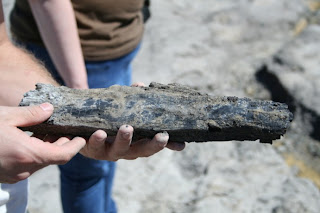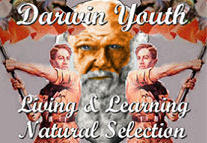 Yesterday a group of Kansas fossil hunters went back in time to around 99 million years during the Cretaceous period when East Central Kansas and Nebraska were at the edge of a vast inland sea. The Cretaceous was a period of rapid change that saw the rise of many modern groups and extinction of many others.
Yesterday a group of Kansas fossil hunters went back in time to around 99 million years during the Cretaceous period when East Central Kansas and Nebraska were at the edge of a vast inland sea. The Cretaceous was a period of rapid change that saw the rise of many modern groups and extinction of many others.The trip was led by Julie Retrum, geology graduate student and Jonathan Hendricks, a post doctoral researcher from Cornell. The trip's goal was to visit a couple of important sites to collect material for the paleontology collections. We began our trip at 7:15 am in the parking lot behind Lindley Hall at the University of Kansas with Julie and Jonathan providing a briefing about where we were going, and the ground rules for collecting specimens.
 We then headed north on 75, not stopping at the world's largest cinnamon roll in Holton and seeing none of the world famous black squirrels in Marysville KS, but going on into Nebraska to our first stop, an old cropping of sandstone-no fossils but as one hunter remarked it was like walking on a beach. There were also interesting nodules littering the site along with crystals of gypsum, but alas no fossils.
We then headed north on 75, not stopping at the world's largest cinnamon roll in Holton and seeing none of the world famous black squirrels in Marysville KS, but going on into Nebraska to our first stop, an old cropping of sandstone-no fossils but as one hunter remarked it was like walking on a beach. There were also interesting nodules littering the site along with crystals of gypsum, but alas no fossils.The 'beach at the first site(above)
Gypsum crystals(below)

Our next stop was quarry full of tropical soils. Finding tropical soils in Nebraska may seem odd but this spot during the Cretaceous was a tropical rain forest and we stopped specifically to see these weathered soils. Today these soils are quarried for clay used to make bricks. This didn't seem too exciting until we began to notice what looked like pieces of charcoal in the clay.
 In a sense that is what they were-the carbonized remains of trees from almost 100 million years ago and yet so fresh the grain of the wood was still visible. Some of the pieces had pyrite (fool's gold) in association with them and were quite large and we joked about use them as Yule logs. The quarry manager said the clay is nice and fires very nicely, except that the pyrite explodes taking little chips of the brick with it and then forming little rust spots on exposure to air.
In a sense that is what they were-the carbonized remains of trees from almost 100 million years ago and yet so fresh the grain of the wood was still visible. Some of the pieces had pyrite (fool's gold) in association with them and were quite large and we joked about use them as Yule logs. The quarry manager said the clay is nice and fires very nicely, except that the pyrite explodes taking little chips of the brick with it and then forming little rust spots on exposure to air.A piece of carbonized 'Yule log' (above)
Remains of a swamp(below) with some of our
crew digging for plant fossils (below)
 From there we went to another site, quite famous for its fossils of early flowering plants and the pictures we saw were quite recognizable to my eye as being related to magnolias. This area during the Cretaceous was apparently a brackish swamp. Along with flower parts the leaf fossils from this site are very complete showing the leaf veins and in some cases the cells through which plants take in carbon dioxide for photosynthesis.
From there we went to another site, quite famous for its fossils of early flowering plants and the pictures we saw were quite recognizable to my eye as being related to magnolias. This area during the Cretaceous was apparently a brackish swamp. Along with flower parts the leaf fossils from this site are very complete showing the leaf veins and in some cases the cells through which plants take in carbon dioxide for photosynthesis. Alas, we mainly found small bits of plant material, no flowers. Also the clay containing the plant material was very damp and fragile, often disintegrating when handled. Let the clay dry and the plant material would blow away in the wind unless sprayed right away with a fixative. Quite a dilemma! Several people did find some nice pieces of fossilized wood in a dry creek bed at the bottom of the site.
Alas, we mainly found small bits of plant material, no flowers. Also the clay containing the plant material was very damp and fragile, often disintegrating when handled. Let the clay dry and the plant material would blow away in the wind unless sprayed right away with a fixative. Quite a dilemma! Several people did find some nice pieces of fossilized wood in a dry creek bed at the bottom of the site.Bits of compressed plant material from the brackish swamp site(above)
Wood from this site(below)

 In addition to the KU contingent, two local volunteers Lois (Bottom right in the green hat) and John directed us to our last 'dig' , a road cut back in Kansas about 9 miles west of Washington Kansas-that during the Cretaceous was open ocean- guaranteed to have fossil clams.
In addition to the KU contingent, two local volunteers Lois (Bottom right in the green hat) and John directed us to our last 'dig' , a road cut back in Kansas about 9 miles west of Washington Kansas-that during the Cretaceous was open ocean- guaranteed to have fossil clams. They were right and we didn't even have to dig. The clams turned out to be all one species of a group of clams called Inoceramids, which are extinct today and we all collected our fill. Some Inoceramids got to be 8 foot long and sometimes fossil fish are found inside the clam, apparently having used the clam for a refuge.
They were right and we didn't even have to dig. The clams turned out to be all one species of a group of clams called Inoceramids, which are extinct today and we all collected our fill. Some Inoceramids got to be 8 foot long and sometimes fossil fish are found inside the clam, apparently having used the clam for a refuge.A beach, a jungle, a swamp and a clam bed all within an hour's drive and almost 100 million years away-what a treat-and I found myself imaging Leonardo da Vinci shaking his head at the people driving by these sites daily and yet snug in their view that Genesis explains geology and ignorant of the science he helped found.

Other Links:
The History of the Earth and the History of Life.
Charles Sternberg: fossil hunter.
Technorati Tags:
Kansas
Fossils
Evolution












